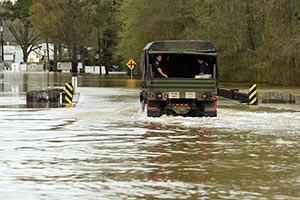Louisiana Flooding Affects Freight Movement in State

Saia Inc., No. 25 on Transport Topics’ Top 100 list of the largest for-hire carriers in the U.S. and Canada, shut down its terminal in Baton Rouge on Aug. 15 and Aug. 16 after limiting operations in three of its other seven terminals in Louisiana on either Aug. 12 or Aug. 15. Saia spokeswoman Jeannie Jump said the Baton Rouge terminal where water reached the doors of some tractors re-opened on Aug. 17.
“Things are getting better,” said Jump, whose company has about 500 employees in Louisiana. “We’ve been taking it day by day. We had to go into the Baton Rouge facility and evaluate the facility and our equipment. We’ll be working through the freight we had on hand. We appreciate our customers’ patience. It’s such a national story, I think people understand the situation. They know that the most important thing for us is that our employees and their families are safe. We’re not going to put anyone in danger by putting them on the roads.”
Jump added that the timing of deliveries will depend on road conditions.
While I-12, which runs from west of New Orleans to Baton Rouge, re-opened early on Aug. 16 and I-10 opened Aug. 17 eastbound but reopened in the westbound direction solely for commercial traffic.
“It’s a major disaster,” said Rodney Mallett, spokesman for Louisiana’s Department of Transportation and Development. “Everybody in Baton Rouge has a friend or family member who’s lost everything. Some people haven’t been able to get to their homes to see the damage. Some are trying to get around by boat.”
Mallett said that any truckers who were stranded by the roiling waters have been rescued. He advised trucks heading west to take I-55 north from I-10 in Greater New Orleans to I-12 before picking up I-10 in Baton Rouge.
He added that drivers should check with local authorities before attempting to drive in their destination parish. Motorists also may check the updated road closure list by calling 511 or by visiting the web site 511la.org.
The National Weather Service said the potential for more heavy rain and flooding continues. This kind of storm isn’t that unusual for Louisiana. Nearly 27 inches fell from March 8-11 near Monroe in the southeastern part of the state, prompting record local flooding.
“What’s another couple of inches when we’ve had 24-30?” Mallett said. “We think the worst is over, but we’re still advising everyone to be extremely careful.”

